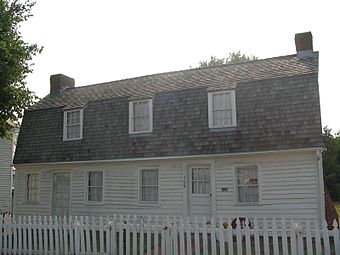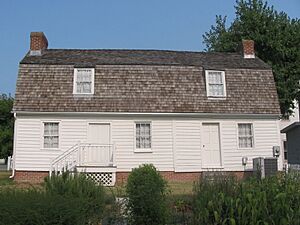Cray House (Stevensville, Maryland) facts for kids
Quick facts for kids |
|
|
Cray House
|
|
|
U.S. Historic district
Contributing property |
|

House in 2007
|
|
| Location | 109 Cockey Lane, Stevensville, MD, USA |
|---|---|
| Nearest city | Stevensville |
| Area | less than one acre |
| Built | 1809 |
| Architectural style | Post & Plank Log Cabin |
| NRHP reference No. | 83002960 |
| Added to NRHP | May 9, 1983 |
The Cray House is a special two-room house located in Stevensville, Maryland. It was built a long time ago, around 1809. This house is important because it's a rare example of a building style called post-and-plank construction. It also shows us what many small houses in the area used to look like. Because of its unique history and building style, the Cray House was added to the National Register of Historic Places in 1983.
Contents
The Cray House Story
The Cray House was built in two main parts. The first part was constructed around 1809. The land where the house stands was originally called "Steven's Adventure." This name came from Francis Stevens, who received the land in 1694.
How the House Grew
The first section of the house was a one-and-a-half-story building with three sections. It was built using a special post-and-plank method. Later, another section was added to the south side. This new part also had three sections. At that time, the original roof was changed to a gambrel roof, which is a roof with two different slopes on each side. This new roof covered the entire house. The finished house looked very much like other homes built in Queen Anne's County, Maryland during the late 1700s and early 1800s.
New Owners and a New Purpose
In 1914, the house was sold at an auction. A woman named Nora Cray, who was a widow, later lived there with her nine children. This is how the house got its name! In 1975, Nora Cray's family gave the house and its land to the Kent Island Heritage Society. This group worked hard to fix up the house, furnish it with old items, and open it to the public. Today, you can visit the Cray House and learn about its past.
How the House Was Built
The older part of the Cray House is still very organized. It has a main door on each side, with windows that have six small glass panes on the top and six on the bottom. The north side of the house has a plain wall. The chimney is made of exposed brick up to the second floor. Many houses in the county shared these features.
Unique Construction Style
The original house was quite small, which was common for homes of its age in Tidewater Maryland during the 1800s. What makes the Cray House special is its post-and-plank construction. This building method was unusual in Tidewater Maryland. Even more rare are examples like this one, where the planks run from one corner to the other. The Cray House was one of the first examples of this style to be discovered.
The house has a hall-parlor plan. This means it had only one room with a fireplace on each floor. Even though it was small, it had nice decorations inside. These included special wooden boards, a two-piece chair rail, and a fancy mantel on the first floor.
The Smokehouse
Behind the main house, there is also a smokehouse. This building was not originally on the property. It was moved there because it's a rare example of a building that used to be very common in the area. Today, the smokehouse is used as a gift shop for visitors to the Cray House museum.
Why the Cray House is Special
When the Cray House was first found, people thought it was the only one of its kind with this unusual post-and-plank construction. Later, more research showed that other similar buildings still exist in Tidewater Maryland. However, many of these buildings are in danger of falling apart. Most of them are small farm buildings or have been changed into kitchen areas for bigger houses. The Cray House, along with two other similar buildings in southern Maryland, are some of the only ones that are still mostly intact as homes.
The Cray House is one of many historic buildings in Stevensville. Many of these buildings are part of the Stevensville Historic District. The Cray House was listed separately, but it is right in the middle of this historic area on Cockey Lane. Nearby, you can find the Stevensville Train Depot, and just down the street are the Old Post Office building and the Stevensville Bank.





